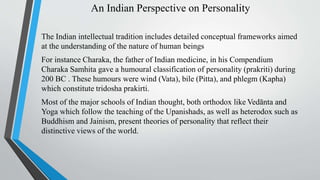This document provides an overview of personality theories including:
- Gordon Allport's definition of personality as the unique patterns of behavior, thoughts, and feelings that determine an individual's adjustment.
- Allport's categorization of traits into cardinal, central, and secondary traits. Central traits form the basic personality foundations while secondary traits appear in specific situations.
- Raymond Cattell's identification of 16 source traits underlying surface personality traits through factor analysis. He developed the 16PF questionnaire to measure these traits.
- The Big Five model which proposes there are five key dimensions of personality that can be remembered with the acronym OCEAN.











































































